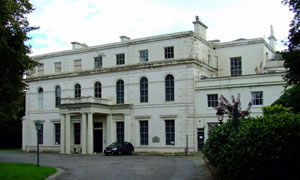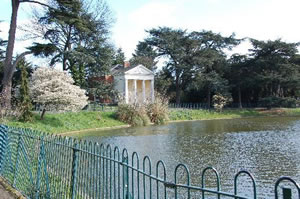Latest On Gunnersbury Park Restoration
More details of the exciting plans for the Museum and Park
The Chairman of the Friends of Gunnersbury Park James Wisdom and fellow Committee member Val Bott have revealed some more details about the huge project to restore Gunnersbury Park.
Plans for some parts of the refurbishment, particularly the Museum, are nearly complete, though for other areas of the Park, the Friends are still exploring a number of different possible options, they have disclosed to this site.
Wisdom and the other restorers are keen to raise the Gunnersbury Park Museum's status as the local history museum for both Ealing and Hounslow. As we already know the Large Mansion, which holds the Park Museum, will be restored and made more easily accessible to visitors, with a lift to be constructed. This project will be funded by the £4.1 million granted by the Heritage Lottery Fund at the end of July.
With more of the Large Mansion, pictured below, opened up to visitors, and the impressive - but also space-consuming - transport collection moved to a new home as part of the cafe extension, curators will have a good deal more space to tell the story of the two boroughs. The Museum has been collecting since the 1920s, but most items have had to be placed in storage due to lack of room. James and Val have expressed their excitement that the Museum will be able to reveal more of the local story to visitors and celebrate what has happened in Ealing and Hounslow throughout the centuries.

(The Large Mansion, home to the Gunnersbury Park Museum)
A key part of the bid to receive funds to restore Gunnersbury Park was a promise to further increase the use of the Museum by local schools. As a result, there will be a dedicated learning space on the top floor, which will be used as a base for school visits. The learning space will also be available for adult visitors to work in.
Another £4.7 million has been granted by the Heritage Lottery Fund and the Big Lottery Fund's Park for People programme to radically restore the Park as well as the Museum. Much attention will be given to what restorers term the "Historic Core" of Gunnersbury Park, the gardens around the two Mansions. This area, along with the Stables and Orangery, will see the most significant bits of restoration. As part of the preliminary stages of the restoration bid, each of these areas underwent archaeology tests last summer. As has been widely reported, part of the Horseshoe Lake, a feature of the 18th and 19th century Park, will re-emerge after the restoration.
Some of the changes which will be most noticeable to future visitors are relatively minor, simple changes to the environment: expect new gravel paths to replace tarmac and better reflect a verdant and historic park. A community garden has already been tentatively established in a former walled kitchen garden north of the Stables.
Val Bott in particular outlined the ethos for the restoration of the Park grounds in terms of 'unpeeling the layers' of Gunnersbury Park's history. The Park has been used continuously for several centuries, under a number of owners and for a number of different purposes. The renovation hopes to present to visitors the great diversity of the experiences our forbears have had walking through Gunnersbury Park.

(Decay has been halted to the Potomac Tower)
This will unearth some forgotten facets of the Park: regular visitors will perhaps be surprised to hear that the strange stone steps near to the playground were originally used for the lavish polo tournaments which the Rothschild banking family held in Gunnersbury Park over a century ago. In addition, for those wondering why a number of buildings and roads on the edge of the Park take the name 'Clayponds', this refers to the burgeoning local clay industry of the 18th century; the Potomac Lake in particular had a reputation for fine and long-lasting clay, indeed its Tower (pictured above) doubled as a kiln once upon a time. It is hoped that the renovation will help bring out more colourful details like these to Park visitors.
As to the future of the Potomac itself, things are less well-developed. Crucially, the decay to the Potomac Tower has been halted, but funds for the building and lake are not unlimited, and the project team are still exploring a number of options in this area.

(One of the carriages to be displayed in the new Local Transport exhibit)
One of the most highly-anticipated aspects of the restoration, along with the return of boating to the Round Pond, has been the building of a new cafe on the site of the old one. A confirmed extension to this cafe will host a local transport exhibition room, to feature stunning objects like the Rothschild family's carriage and the first hansom cab in Ealing. Again, the restorers are still deciding upon exact details, such as the nature of the new cafe and its connection with the transport exhibit, but it is expected that the interest generated in the extension will require a system of managed entry.
Sports funding, for instance to replace the changing rooms which burnt down several years ago, is unfortunately not included in the lottery funding. Sports teams based in Gunnersbury Park will have to apply to the individual national associations, the FA, RFU and the ECB for instance, to gain the necessary funds. Nonetheless, it is hoped that Gunnersbury Park and Museum's lottery wins will provide momentum to other campaigns, and make grass-roots investment in the area more attractive.
One major sporting change which is certain to happen is the relocation of the golf course to another part of the Park. This was requested by the Pitch and Putt company itself, who felt the course - designed in the 1920s - needed updating to stimulate more interest. This should also make a big difference to visitors too, as it will open up a vast swathe of field at the heart of the Park previously closed to walkers.
Joe Kelly
September 26, 2014
Related links
|
